Purpose – The aim of this paper is to identify innovation impact on agriculture production and assess absorptive capacity of agricultural in terms of innovation.
Methodology – Analysis of current situation in agriculture, comparison analysis, correlation model and regression analysis are the methodology of this paper.
The value of the research is to defining innovation absorptive capacity of agriculture enterprises and farmers that leads to improve food-ensuring potential of the whole country.
Finding – Research results demonstrate strong position of agriculture enterprises among other producers; also, they are main providers of innovation. This research paper can be applicable for government agricultural policy as well as farmers, agricultural enterprises.
Introduction
This research paper is aiming to explore the importance of fostering innovation in agriculture, as well as identifying the necessity of improving farmers’, agricultural enterprises workers’ knowledge in order to achieve that big goals defined by government in agriculture sector. Therefore, this paper comprises three components of research, which means only via integrating of them ‘defined goals’ can be achievable.
Apart from, this research paper aims to expand our understanding in terms of importance and necessity of innovation in variety sectors and interdependence of innovation with knowledge transfer. Therefore, we try to uncover positive impact both innovation and knowledge on agriculture development. Thus, three components are agriculture indicators in order to analysis and figure out core problems and possible ways to solve them by highlighting perspectives; current situation of applying innovation in agriculture and understand whether innovation challenges agriculture sector or it leads to better side; absorptive capacity of farmers, agricultural entities, that means readiness of farmers in receiving necessary knowledge in order to be kept with the times.
To be exactly, often there is a question "Why it is difficult to introduce achievements to agriculture?" We think that core of this problem is lack of knowledge of farmers, agriculture workers in applying these technologies. This problem points out the necessity of improving vocational education in agriculture.
It seems to us that agriculture is one of the vulnerable sectors of economy; therefore, we came up with an idea that government’s policy in terms of supporting agriculture is intertwined.
This research topic embraces big area; therefore, research will be based on data of only three regions of the Republic of Kazakhstan. Regions will be named oblast. They are namely Almaty, Zhambyl and South Kazakhstan oblasts. Taking into account particular value of agriculture we have to highlight the role of state in regulating, supporting and acting as a gardener. By "gardening", we mean government’s role in holistic view in developing agriculture through utilizing innovation. Be exactly, firstly, government defines how appropriately provide financing in order to support innovation in agriculture. That implies identification of sources to provide "watering" (financing). Secondly, government issues a law to regulate agriculture sector in terms of property rights, land distribution, water utilization, and forest protection. Last two years government developed crucial laws such as "Agricultural Cooperatives", "Land Law". These activities describe removing regulatory, institutional, or competitive obstacles to innovation ("removing the weeds and pests"); and thirdly, by strengthening the knowledge base through investment in education and research ("fertilizing the soil"). This point of view is illustrated in picture below based on idea, which developed in guidebook by The International Bank for Reconstruction and Development and The World Bank [1].
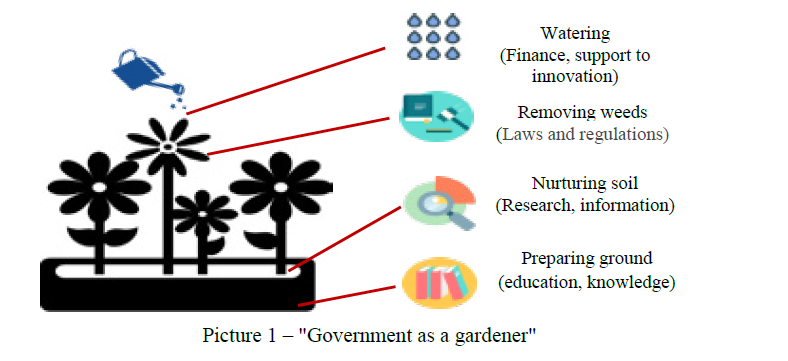
Picture 1 – "Government as a gardener"
One of the supporting mechanisms from government side is to sponsor research and development (R&D). It implies "fertilizing the soil". Internal expenses for R&D increased two times from 3592.3 million tenge in 2011 to 7602.4 million tenge in 2015. That is 8,2% from total expenses in the republic in 2011 and 10,9% in 2015 respectively [2].
These expenses devoted to finance innovation in agriculture. Increasing expenses leads towards to big goal – that means introducing innovation in agriculture. It is the way to sustainable development. In turn, it leads to broader goal, which is knowledge-based economy. Knowledge based economy leads to nurturing competitiveness of economy. This idea mentioned firstly in President’s lectures devoted for the topic "Intellectual Nation" in al-Farabi Kazakh National University and the topic "Innovation industry of science and knowledge is a strategic resource of Kazakhstan in XXI century" in Nazarbayev University [3]. We are aiming to come up with an idea from this perspective. The picture given below illustrates the logical sequences of this idea.

Picture 2 – Interrelation of Innovation, Science and Knowledge [1]
So, what is innovation? There are huge amount of various definitions. Among them we prefer one related with agriculture. It explains that innovation demonstrates applying new knowledge or technique to operational or organizational process particular in this sector [4]. It is useful and beneficial for entire society because new or updated ideas, practices and technologies can alter former ways of working, thinking, as well as acting. Another definition describes ‘Innovation is a result of individuals and legal entities’ activity which implemented as a new or improved product, production method, technology in organizational decision making in terms of technical, operational, administration, commercial in order to ensuring ecological safety and enhance economic efficacy. This definition based on Statistic yearbook about ‘Science and innovation activity of Kazakhstan’ for 2011-2015 [2. pp.3]
According to our research, innovation refers for agricultural enterprises among all agricultural entities (organizations). We mean most agriculture enterprises attempt to adopt innovation and implement it. In tern, these organizations conditionally are divided into agricultural enterprises, peasant farmers and personal subsidiary farming (individual households). Therefore, we will stress on exploring the activity of agricultural enterprises' among all entities of this industry. Each type of entity can be explained by definitions of Statistic Committee of the Republic of Kazakhstan.
Agricultural enterprises are legal entity or its structural division, dealing with production, storing, processing of agricultural products and providing service in agriculture sector.
Peasant farming is an association of people, implementing individual entrepreneurship that tied with land usage in order to produce agricultural products, processing and distribution of them.
Households refer to personal subsidiary farming, collective garden, and vegetable garden.
Analysis of agriculture indicators of Almaty, Zhambyl and South Kazakhstan oblasts
As it is mentioned, in introduction, analytical part of the research paper based on oblasts’ current situation. Innovation plays decisive role in economic development. Obviously, it is not easy to implement and realize it agriculture. First of all, let’s try discussing it in terms of variety perspectives. Interesting fact that attracts our attention is population distribution in researched oblasts. For instance, number of population in Almaty in 2015 at the end of year was 1947481 people. Rural population is 1476759 people (84,5%) [5]; this situation requires to improve rural life condition. Regarding South Kazakhstan oblast the same situation, total population number is 2840600 people, 1563200 people are rural population (55%) [6]. As for Zhambyl oblast,
[7] there is out of 1110900 people, 661300 people live in rural places (59,5%), it also indicates that there is a place for innovation. Total population of the republic was 17670,6 thousand people at the end of 2015, so 33,4% live in south part of Kazakhstan.
Next indicators deserves to be taken into consideration is structure of agricultural building and facilities, how they are distributed.
The number of available all building and facilities in plant production of agriculture in the republic was 120682 items, and in livestock production was 1835282 items in 2015. In both production types vast majority of buildings and facilities belong to personal subsidiary farming (plant production 106577), that is 88,3%; and out 1835282 items 1763071 possessed by personal subsidiary farming, it is almost 96%. However, repairing workshops, technical service centers of agricultural techniques are completely belong to agriculture enterprise. There are 1879 repairing workshops in the republic. Agriculture enterprises have 1737 of them, nearly 92%. 181 technical service centers of agricultural techniques are located in Almaty, Zhambyl and South Kazakhstan oblasts, it is 10,4%. We think is not enough, because almost 68% of agriculture enterprises are located in these oblasts. According to statistic data out of 7271 enterprises, 4907 of them located in these oblasts (in Almaty – 604, in Zhambyl – 257, in South Kazakhstan oblast – 4907 enterprises) [8].
The production capacity of agricultural enterprises based on varieties of equipment. Consider, number of equipment for milk processing is 228 items, out of this number agriculture enterprises possess 199 items, which is 87%; grinding equipment – out 2132 items 551belong to agricultural enterprises; production bakery products' equipment is 496, and 371 of them are owned by agricultural enterprises. All these indicators show production potential of agricultural enterprises.
After analyzing previous information, we would like to find out agriculture enterprises' structure by types of products. Next table illustrates the absorptive capacity and innovation introduction potential of oblasts.
Table 1 – Number of agricultural enterprises in Almaty, Zhambyl and South Kazakhstan oblasts
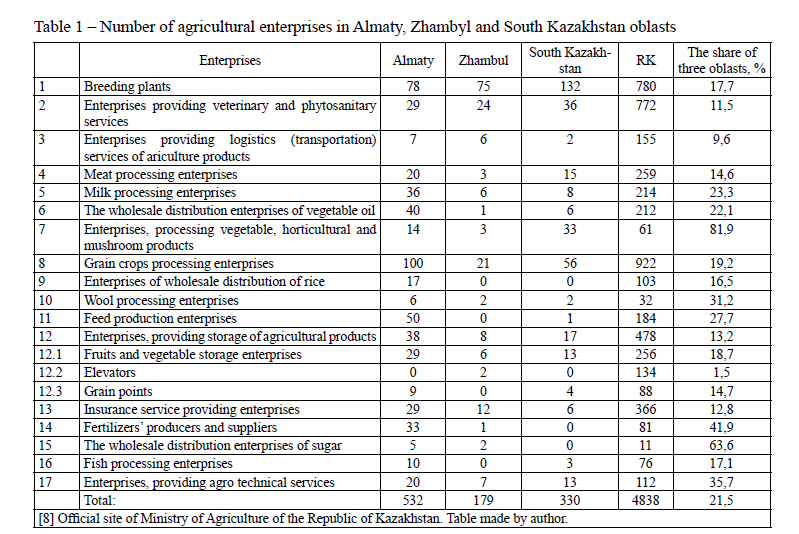
Among 38 meat processing enterprises of 3 oblasts, only 17 of them have their own cattle in Almaty and South Kazakhstan oblasts. Both oblasts Zhambyl and South Kazakhstan oblasts purchase milk from households. Among 36 milk processing enterprises only 7 of them have their own milk, rest of them purchase form households in Almaty oblast.
Almaty oblast has 19 milk plant; total production capacity of these plants by raw materials is 315719 tons, by product 148150 tons of milk. The number of employees in these enterprises is 1542 people [9]. Milk production per capita was on the same level last 10 years. Information is given in the table below.
The wholesale distribution enterprises of vegetable oil produce sunflower oil. For instance, 28 enterprises have their own raw materials. This is a crucial for native economy.
The potential of enterprises, processing vegetables, horticultural and mushroom products in Almaty and South Kazakhstan oblasts is high. Almost 82% vegetable processing enterprises are concentrated in south part of Kazakhstan. It is true. In 2015 these three oblasts produced 2445,4 thousand tons of vegetables (gross output), which is 68,6% from the republic production level [10]. There is an important indicator that also indicates food-ensuring potential of oblast, namely production of agriculture product per capita. It is illustrated in the table, capturing last ten years.
Table 2 – Production of agriculture product per capita, kilograms
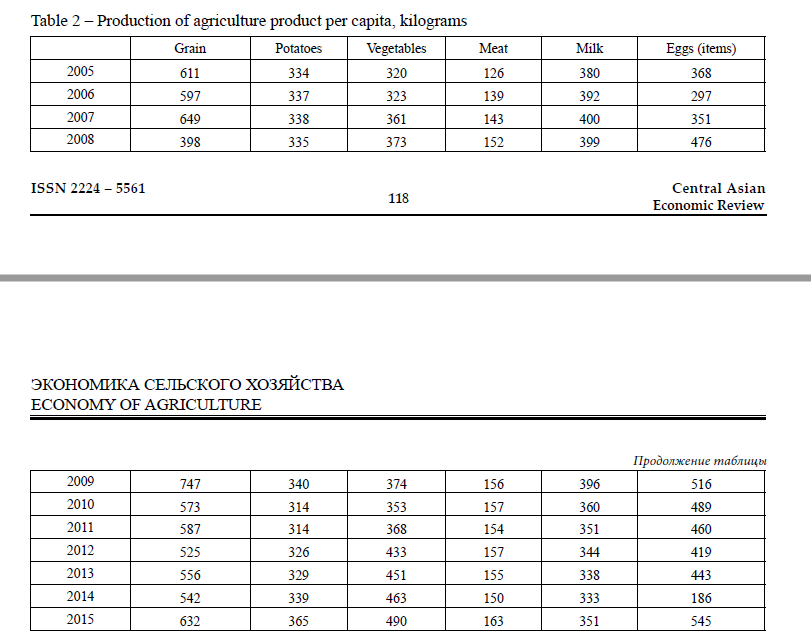
According to the given table, all six products have growth tendency, but not all are the same. Production of grain and eggs is fluctuated during given period; meat and vegetables production has constant growth. That implies satisfying internal needs of population. In addition, this indicator defines export potential of the oblasts. It is seen in next table consumption of products per capita on the example of Almaty oblast.
Table 3 – Consumption of agriculture products per capita in Almaty oblast, kilograms

The table depicts exceeding consumption of all types of product, except potatoes in Almaty oblast. However, there are differences and similarities between oblasts in food consumption. For instance, focus on 2015 – meat consumption in South Kazakhstan 41 kg. per capita, and 66 kg. in Zhambyl; consumption of milk in South Kazakhstan – 207 kg. per capita and in Zhambyl – 167 kg. per capita; regarding vegetables consumption – 111 kg. in South Kazakhstan oblast and 88 kg. in Zhambyl respectively. Consumption of bread is almost the same in all oblasts.
By analyzing livestock production and number of cattle heads in three oblasts we can conclude controversial statement. Nevertheless, not all agricultural enterprises have their own livestock production. Most of them purchase meat from households. Here is a fact that we would like provide comparison analysis with republic level in livestock production of oblasts in 2015. According to the statistic data the number of cattle was 2063.2 thousand heads – it is 33.34% from the republic level; the number of horses 601,6 thousand heads – it is 29.06% from the republic level; and the number of horses 9394,7 thousand heads, it is 52.7% from the republic level. These data demonstrates strong livestock production potential of three oblasts.
Another interesting fact is that livestock production based on not agricultural enterprises, but household’s production.
Cultivated area (arable land territory) is interesting issue. Providing analysis for arable land division among types of agricultural entities, we can see vast majority of land belong to farmers. Cultivated land of agricultural crop is 21 022,9 thousand hectare in 2015, out it 12 771,7 thousand ha are belong to agricultural enterprises.
By conducting this research, we would like to distinguish potential of each agricultural entities. Hence, arable land for cultivation of plant production possessed by farmers and households. Therefore, vast majority of agricultural building and facilities owned by them. However, technical repair services workshops completely owned by agricultural enterprises. In addition, product processing enterprises are also agricultural enterprises. This is an interesting observation, which can assist to formulate certain criteria for further development and discussion among scientists, as well as establishing government’s policy.
Table 4 – Gross output of agricultural product by agricultural entities

This table illustrates general differences and similarities of agricultural entities’ of three oblasts during 15 years. We group three main producers which are agricultural enterprises, farmers and personal subsidiary farming.
The share of agricultural enterprises in gross output of products is vary from oblast to oblast, for instance production of agricultural producers increasing gradually in Almaty oblast form 10,34% in 2000 to 15,28% in 2015. Whereas, in South Kazakhstan its share decreased two times (from 11,71% in 2000 to 8,83% in 2015) and in Zhambyl oblast agricultural enterprises share significantly also decreased from 17,32 in 2000 to 5,54% in 2015, although this oblast had more agricultural enterprises than both other oblasts. As we can notice main contributor of gross output of agriculture production is personal subsidiary farming. Let us describe namely gross output by plant growing and livestock production. Providing this research we collected data for 20 years, it was not possible to put all information in this article, therefore, therefore we decided to describe them only in for last period [13].
Finally, conducting research and analysis for innovation readiness of agriculture we can predict its future by modeling.
Table 4 – Indicators that impact on agriculture growth in Kazakhstan
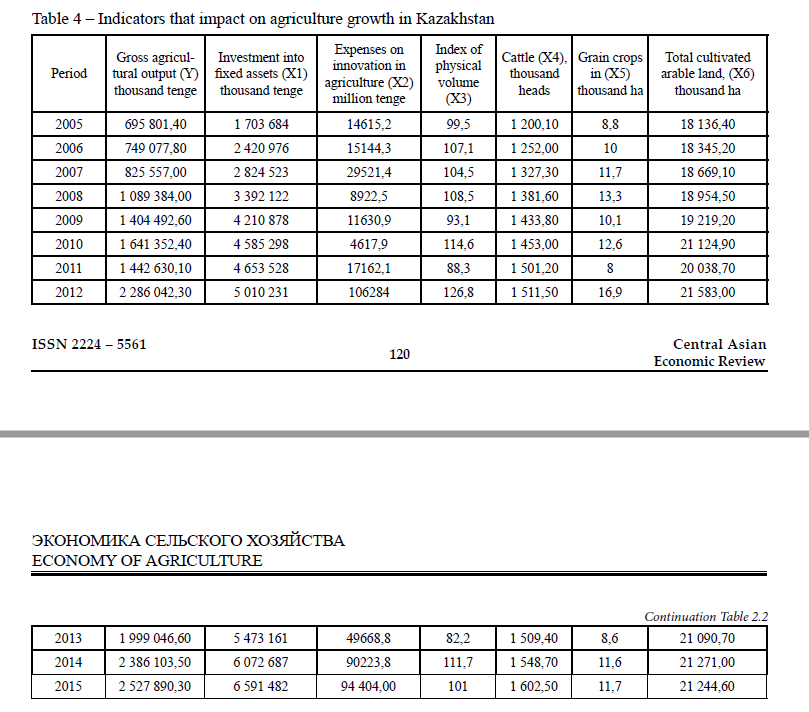
Table 5 – Correlation Matrix

On the basis of this matrix 3 factors were chosen X1, X2 and X6. Regression model were created based on those factors.
The model is:
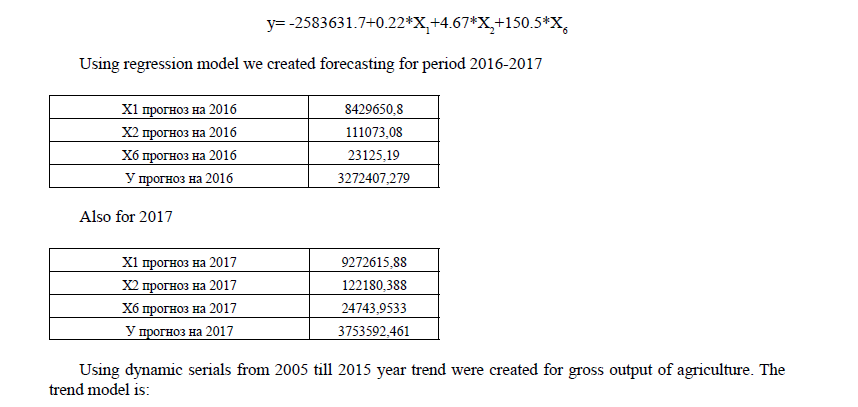
Determination coefficient (R2=0.93) indicates the reliability and adequate of trend model.

Innovation in agriculture today: challenges and perspectives. Knowledge transfer issues
This part of research paper based on local governments' (akimats) reports, official papers. Otherwise, it is not possible to rely on other sources. Because the innovation implementation in agriculture is provided mostly by government support [14]. This principle is so called "The Government as a Gardener" (we mentioned it in the beginning part of the paper). That means government provides innovation policy, which links several industries together. This linkage leads to build a bridge between industries, consequently, to achieve balance (earlier it called intersectorial balance). The reason why do we allocate separately innovation challenges agriculture, the root of introducing innovation should not be replacement of people by machine or innovatively produced some drags for soil can damage the soil, for instance. As we know, automation makes to reduce labor force, which leads to arisen social issues. Therefore, everything is going to be done should lead towards to keep balance. This is first aspect.
Secondly, the role of namely agricultural enterprises is important in innovation implementation in agriculture sector. Through analyzing production capacity of exactly agricultural enterprises, (we do not reject peasant farmers' opportunity to introduce innovation) we came up with this statement. We would recommend strengthening agricultural enterprises position, because they are main providers of innovation in agriculture.
Thirdly, interrelation of innovation, science and knowledge. This process described by pictures 1 and Considering foreign experience, by studying literature we understood the importance of alignment all components together as it is in the concept "Agricultural Innovation Systems". This concept well-known among developed countries. Is assumes expanding agriculture market, application of knowledge by different organizations and meanwhile to emphasize effect. This system can be designed by scheme. This scheme explains interconnections of different organizations that can serve entire agricultural

Picture 3 – Components of "Agricultural Innovation Systems"
Innovation and knowledge are intertwined issues. By conducting research we encountered that introducing innovation is a core issue for developed countries as well. Let say, in Europe economic growth is considered as a result of combination of five ambiguous objectives such as innovation, education, research, poverty reduction, climate change issues. All together are manageable in the frame of rural development. That means agriculture considered as an element of rural development. Through conducting research Europe countries figure out six priorities in implementation innovation in agriculture and one crucial element is fostering knowledge transfer in this sector. This point of view we would recommend to adapt.
Introducing innovation is not easy process. Because most of innovations did not achieve the farmers. This problem shows research gap. How to build effective communication bridge between academics and farmers in agricultural sector in Kazakhstan. A group of scientists discussed this problem in the frame of workshop in 14-18 November 2016 in Almaty.
Finally, we understood currently what considered as innovation in agriculture sector. It is introducing and application innovation via purchasing and utilizing agricultural equipment and machines as well as usage of mineral and organic fertilizers and applying drop irrigation. All these mentioned are in process in Kazakhstan. This is good. However, one is missing, it is knowledge transfer. That is the main aim of this research paper. When we started to outline our research, we aimed to try building a "bridge". How farmers get knowledge and are informed current situation and development. There are lots of internet sources. Which we are going to share with list of sites [15]. Through this research we also encountered with interesting statement concluded by Michio Kaku, who is an American scientists. He shared with his thoughts and gave food for thoughts by saying "Nations who rely on agriculture, will not last long, they are doomed to poverty". His claim points out necessity of innovation.
Last, but not least, ability to use internet information, get communication via it also facilitates to improve the farmers’ knowledge.
Conclusion
Agriculture is a core industry for Kazakhstan. Its value is priceless. Kazakhstani Government has been supporting agriculture for decades in order to introduce innovation.
In this paper, we aimed to grasp interrelation and interdependence of three components and tried to link them through various indicators. Analyzing current agriculture indicators allowed figuring out core problems and possible ways to solve them by highlighting perspectives. We found out actually how innovation is going to be implemented and only improving vocational knowledge absorptive capacity of farmers, agricultural entities, will be effective.
In addition, we came up with conclusion that there is a positive impact both innovation and knowledge on agriculture development.
We also understood powerful role of government as gardener as regulator by issuing a law in order to function in market condition properly.
References
- World Innovation Policy: A Guide for Developing Countries. World Bank // World Bank. – 2010. – URL: https://openknowledge.worldbank.org/handle/10986/2460 (accessed: 16.12.2016)
- Statistic yearbook. Science and innovation activity of Kazakhstan, for 2011-2015. – 2016. – URL: http://stat.gov.kz (accessed: 11.2016)
- Official web-site of the President of the Republic of Kazakhstan [Electronic Source]. – 2017. – URL: http://www.akorda.kz/ru/nazarbaev-universitete (accessed: 02.2017)
- Jose San Innovation in agriculture: a key process for sustainable development. Institutional position – Inter-American Institute for Cooperation on Agriculture. – 2014. – URL: http://repositorio.iica.int/ bitstream/11324/2607/1/BVE17038694i.pdf (accessed: 03.04.2017)
- Statistic Preliminary statistic data for 2015 in Almaty oblast [Electronic source]. – 2016. – URL: http://stat.gov.kz/faces/almatyobl/ (accessed: 06.02.2017)
- Statistic Preliminary statistic data for 2015 in South Kazakhstan oblast [Electronic source]. – 2016. – URL: http://stat.gov.kz (accessed: 06.02.2017)
- Statistic yearbooks. Preliminary statistic data for 2015 in Zhambyl oblast [Electronic source]. – URL: http://stat.gov.kz/faces/zhambyl/ (accessed: 02.2017)
- Official web-site of the Ministry of Agriculture of The Republic of Kazakhstan [Electronic Source]. – 2017. – URL: http://mgov.kz/ru (accessed: 03.2017)
- Official web-site of the Governance of Almaty Region [Electronic Source]. – 2017. – URL: http:// zhetysu.gov.kz/ru (accessed: 11.2016)
- Statistic yearbooks. Agricultural, forest and fish in the Republic of Kazakhstan for each year 20112015 [Electronic source]. – 2016. – URL: http://stat.gov.kz/faces/almatyobl/ (accessed: 02.2017)
- Official web-site of the Kazakh Academy of Nutrition [Electronic Source]. – 2017. – URL: http:// www.kan-kaz.org (accessed: 11.2016)
- Statistic yearbooks. Agricultural, forest and fish in the Republic of Kazakhstan for each year 20002016 [Electronic source]. – 2017. – URL: http://stat.gov.kz/faces/almatyobl/ (accessed: 02.2017)
- Tankiyeva A. , Yessenkulova Zh. Zh. Agricultural potential of regions in ensuring food security of Kazakhstan // Central Asian Economic Review. – 2017. – № 2. – pp. 100-110.
- O'Connor Christina, Kelly Stephen Facilitating knowledge management through filtered big data: SME competitiveness in an agro-food sector // Journal of Knowledge Management. – 2017. – № 21.
- Official web-site of the Centre of Agro-commerce [Electronic source]. – 2017. – URL: http://shk. fermers.kz (accessed: 15.01.2017)